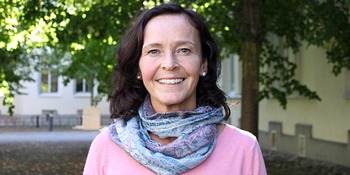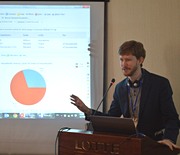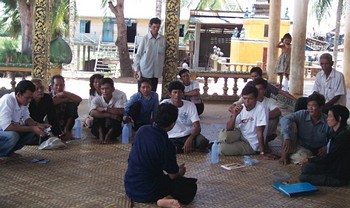Capacity development is crucial to enable stakeholders to fully engage in our research and analysis, benefit and learn from it, and take ownership of the results.

Åsa Gerger Swartling has been part of SEI for more than 22 years, leading many projects involving stakeholder engagement, collaborative learning and capacity-building to support climate change adaptation, resilience-building and sustainability. She has also led SEI’s Transforming Governance theme, and co-leads the Climate Services Initiative. Last summer, she was chosen as SEI’s director of capacity development, a newly created role that she assumed fully on 1 January. Below, she outlines her vision for her new job.
Q: How important is capacity-building to SEI’s work?
AGS: SEI is rather unique in that it operates at the intersection of science, policy and practice and across governance levels, geographical regions and contexts. Capacity-building is one of the pillars of our work. It’s crucial to enable stakeholders to fully engage in our research and analysis, benefit and learn from it, and take ownership of the results and move forward after without us. It helps empower people to bring about change, and it fosters more inclusive, equitable and sustainable development.
Q: Capacity-building can mean a lot of things: from training people to use modelling tools, to helping disenfranchised populations to organize, frame problems in their terms, and find their own solutions. Where does SEI’s work fit on this continuum?
AGS: It runs the gamut. SEI’s capacity-building work can look very different across projects and project teams, but one common element is that it’s almost always closely intertwined with our research and policy engagement. We often combine the three in our projects and programmes. We really focus on producing knowledge that is synthesized, decision-oriented, and tailored to the context and needs of the users. That is where capacity-building fits into our work.
Q: You’ve done quite a bit of stakeholder engagement and capacity-building, most recently in the Mistra-SWECIA programme. How have you approached it?
AGS: I’m one of a number of SEI experts who have focused on participatory research, tools and methods. The work spans the entire participatory process, from identifying and mapping stakeholders, to designing and implementing the processes, to analysing and evaluating the results.
SEI increasingly plays an active or leading role in the implementation of multi-stakeholder dialogues that seek to foster shared learning, co-exploration and co-production of knowledge on sustainability challenges related to energy, water, climate change adaptation and other issues. I see competence in this kind of work as crucial to successful capacity-building for sustainable development.

Q: How important are SEI’s tools and the training and support we provide to users?
AGS: That is a different but equally crucial aspect of our work. LEAP [the Long-range Energy Alternatives Planning system] and WEAP [the Water Evaluation and Planning system] have brought sophisticated energy/mitigation and water/adaptation modelling capacities, free of charge or at a modest cost, to researchers, planners and decision-makers all over the world. Their user communities have a combined membership of more than 50,000, and the hands-on training we provide has greatly strengthened analytical capacity in developing countries that sorely need it.
I think the way in which SEI has built capacity through LEAP and its user community as exemplary. The WEAP team is also doing extraordinary work, not only training people to do highly complex analyses, but creating a whole participatory approach to decision support. Yet another noteworthy example is weADAPT, the global knowledge-sharing platform on climate change adaptation run by SEI Oxford. Not only does it make expert research and case studies accessible to people all around the world, but it really fosters dialogue, collaboration and mutual learning.
Q: Where do you see the greatest potential for growth and improvement?
AGS: There is much more we can do to fully integrate capacity-building, outreach and stakeholder engagement into all of our work. Until now, we haven’t been able to invest in a strategic leadership function for our capacity development agenda and portfolio, and consequently we have lacked a more reflective, coordinated and systematic approach to engaging with our stakeholders. This has also limited our ability to be more proactive as a global think tank and agenda-setter for capacity development in the sustainability domain.
We can also do much better at coordinating and mobilizing our in-house capacity – expertise, tools, methods and approaches – to ensure we’re all applying best practices. And we need to identify gaps and needs across SEI in order to develop our work further. I would like to foster a cross-centre and cross-thematic learning culture around capacity-building issues within SEI.

Q: This week you sent out an email to all SEI staff introducing your new role and inviting them to get involved. How will you be connecting with your colleagues across the institute?
AGS: I’m here for everyone, but I will also be sending regular updates together with our research director [Måns Nilsson]. We also plan to develop an online capacity development hub to exchange knowledge and ideas in an interactive way. And I will work with colleagues who have already begun to approach me with requests and ideas, including possible collaborations with the Climate Services Initiative and the Gender and Social Equity Programme, as well as a new project on implementing the 2030 Agenda on water issues in the Middle East and North Africa.
I’ve also enlisted Julia Barrott of SEI Oxford, the knowledge manager of weADAPT, to be my assistant. She’ll be helping me to develop and systematize our institutional infrastructure on capacity development, including activities, capacities, methods, tools, training and other materials. Julia has lots of experience in capacity development, so it’s great to have her with me.
Q: What would you like SEI to have accomplished in, say, five years?
AGS: My hope is that all three pillars of the SEI strategy – research, policy engagement and capacity development – will be seen as equally important, since they complement one another and are all necessary to fulfil our vision. With increased financial investments from the Swedish government, and with this new director position in place, I think we are well equipped to realize SEI’s potential as an agent of change through capacity-building. We have so many great colleagues working in this field, and there is growing interest across SEI. I think that’s very exciting.
Head of Knowledge Management, Senior Research Fellow
Global Operations
SEI Headquarters
Design and development by Soapbox.
